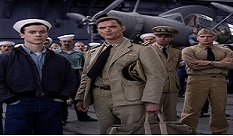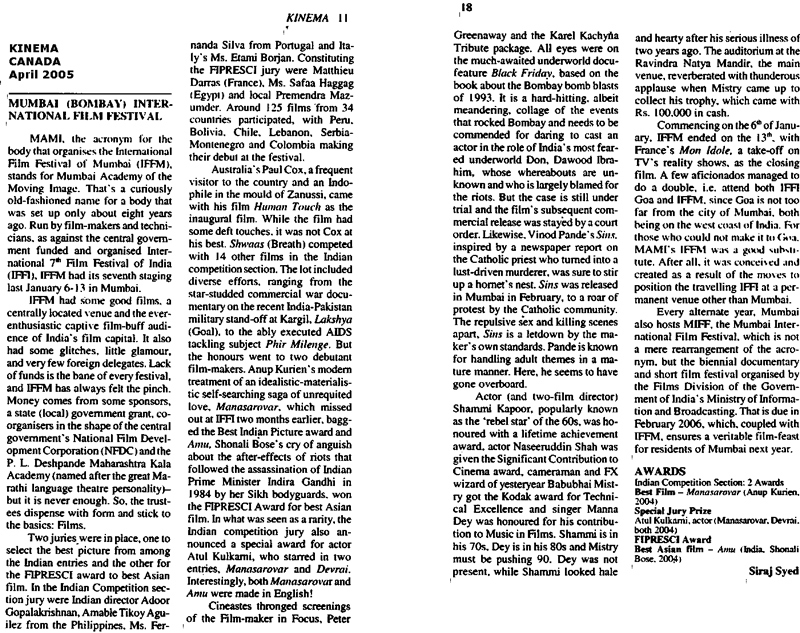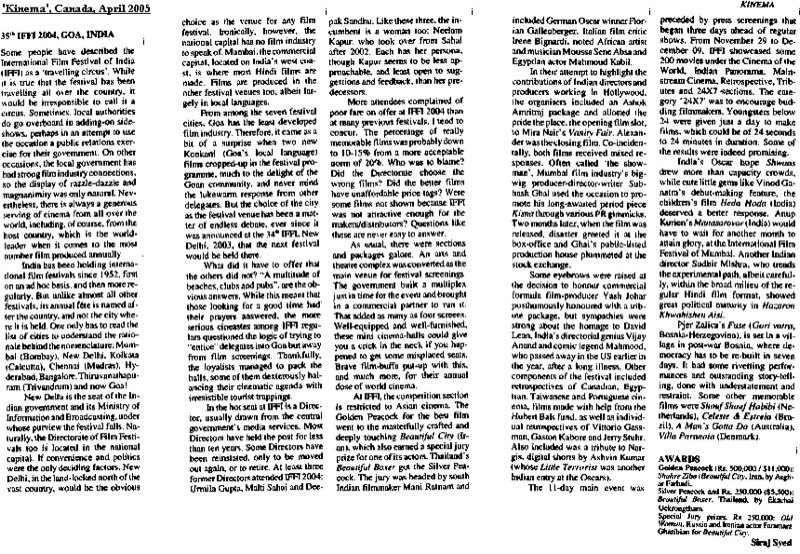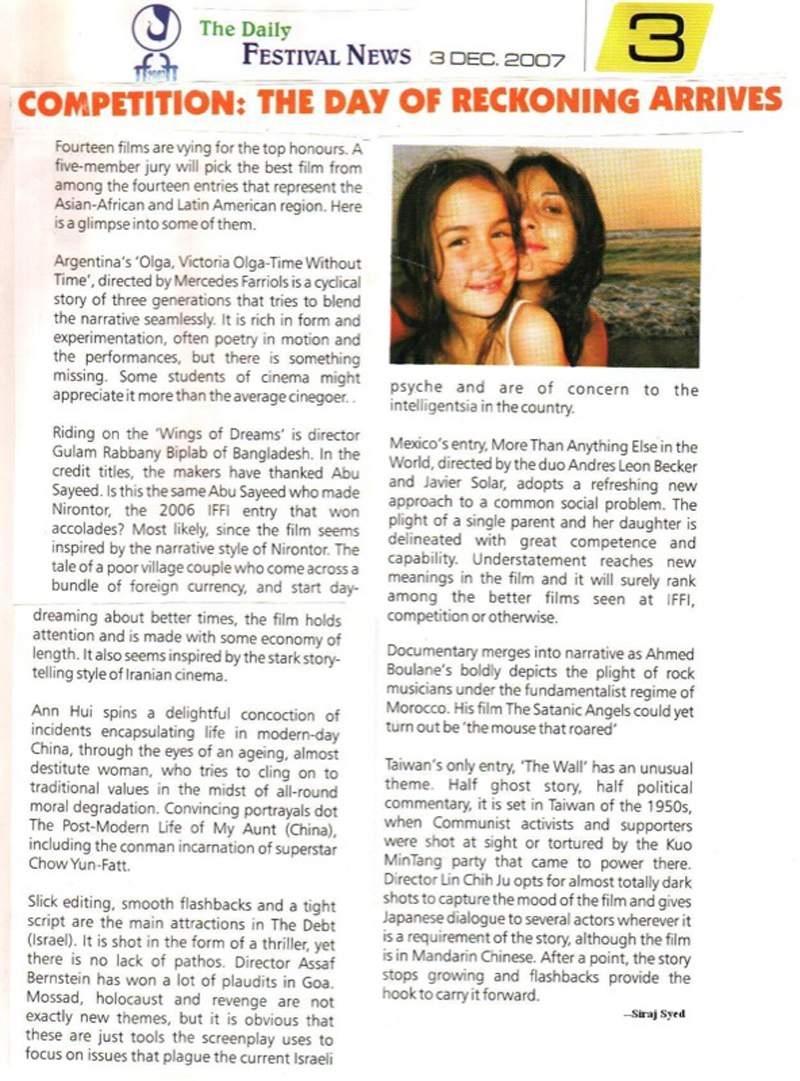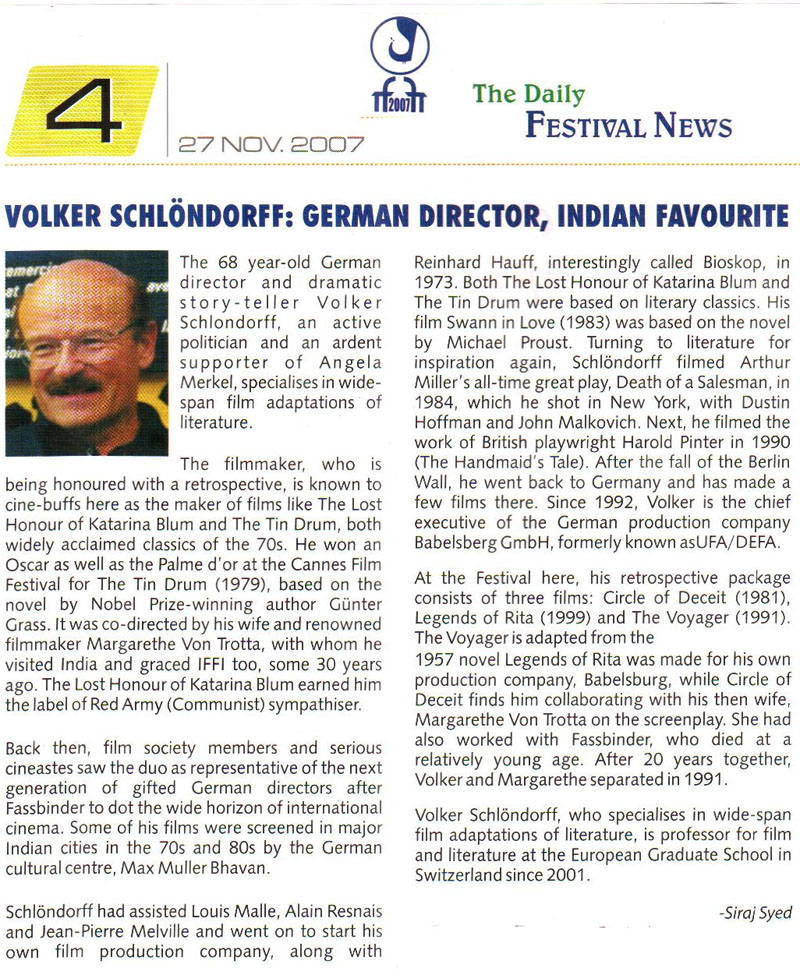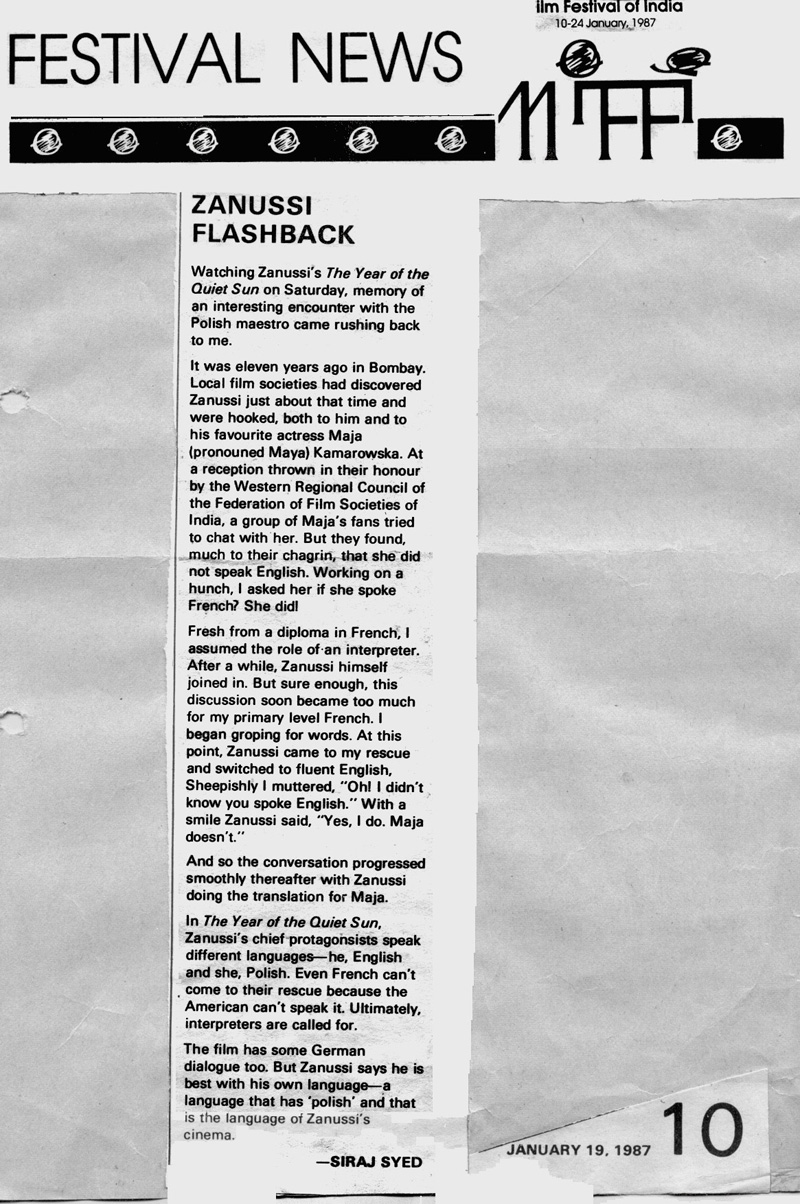|
|
||
|
Pro Tools
FILMFESTIVALS | 24/7 world wide coverageWelcome ! Enjoy the best of both worlds: Film & Festival News, exploring the best of the film festivals community. Launched in 1995, relentlessly connecting films to festivals, documenting and promoting festivals worldwide. We are currently working actively to upgrade this platform, sorry for the inconvenience. For collaboration, editorial contributions, or publicity, please send us an email here. User login |
Siraj SyedSiraj Syed is the India Correspondent for FilmFestivals.com and a member of FIPRESCI, the International Federation of Film Critics. He is a Film Festival Correspondent since 1976, Film-critic since 1969 and a Feature-writer since 1970. He is also an acting and dialogue coach. @SirajHSyed  Midway, Review: Exactly
Midway, Review: Exactly When you make a war movie, based on facts, you might be motivated to give a slightly balanced view of events, for every country that goes to war has its reasons and its heroes. Your sympathies might lie with the nation where the film is produced, yet, unless your motive is jingoism and ultra-nationalism, you will give some weightage to the enemy’s point of view. Also, a faithful recreation means detailing and realistic characterisation, which when juxtaposed against the bombs and bullets, ships and planes, might make you land Midway on the film’s scoring graph. That is indeed the case with Midway, which begins where Pearl Harbor ends. Over a period of 77 years, there have only been three movies on the Midway Atoll Battle. (About a dozen celluloid and TV movies have been made on Pearl Harbor). The first was an 18-minute documentary, shot by John Ford, who was injured while filming. Then came the 1976 Midway, directed by World War II veteran Jack Smight and starring World War II veteran actors Charlton Heston, Henry Fonda, Glenn Ford, and Cliff Robertson. And now we have a 138 minute version, directed by the man who made Independence Day and The Patriot. Apassion project of director-producer Roland Emmerich's, since the 1990s, most of the budget was met by fund-raining. It was shot in Hawaii and Montreal, with a production budget of $100 million, including Chinese money, all of which will be hard to recover. The film releases in the USA and India today, which happens to be the War Veterans Day weekend. Special effects are worth every paisa of your ticket money and the actors are good form too. Somewhere along the line, though, the film lacks focus and is deeply fragmented. This is another case of superficial dialogue, too many characters, American-Japanese-Chinese and more, and too many ships and aeroplanes, with names, to remember and follow. For a better understanding of the movie, here’s a summary of the story: Battle of Midway was fought during June 3-6, over four days, an epic clash between the U.S. Navy and the Imperial Japanese Navy, that played out six months after Japan’s victorious attack on Pearl Harbor, which marked the formal entry of the US into World War II. The American Navy’s decisive victory in the Midway air-sea battle and its successful defence of the major base located at Midway Island, dashed Japan’s hopes of neutralising the United States as a naval power, and effectively turned the tide of World War II in the Pacific Ocean. Japan’s efforts to establish clear naval and air superiority in the western Pacific first hit a snag in the Battle of the Coral Sea, in May 1942, when the U.S. fleet turned back a Japanese invasion force headed for New Guinea. Despite the setback, Admiral Isaroku Yamamoto, commander of the Imperial Japanese Navy, was convinced his forces enjoyed a numerical advantage over the Americans, as well as possessing better planes and pilots. Hoping to replicate the success of the Pearl Harbor attack, Yamamoto decided to seek out and crush the rest of the U.S. Pacific fleet, with a surprise attack aimed at the Allied base at Midway Island. Midway is located in the Pacific Ocean, almost equi-distant between the United States and Japan, hence the name. Yamamoto planned a three-pronged approach toward Midway. First, an air attack on the island, launched from four first-line Japanese aircraft carriers, the Akagi, Kaga, Hiryu and Soryu, commanded by Vice Admiral Chuichi Nagumo. Second, an invasion force of ships and soldiers led by Vice Admiral Nobutake Kondo. And finally, once expected U.S. reinforcements from Pearl Harbor arrived, a joint strike by Nagumo’s forces and Yamamoto’s own fleet, which would be waiting 600 miles to the west. A major role was played by Admiral (then Lieutenant Commander) Edwin T. Layton. He served as Pacific Fleet Intelligence officer on several occasions, most notably throughout World War II; he helped predict the planned Japanese attack on Midway. It was he who enlisted the cryptanalysts and predict the Midway attack, which ran counter to the intelligence that Washington had gathered. U.S. Navy cryptanalysts (codebreakers, many of whom were former musicians and familiar with notations!) had begun breaking Japanese communication codes early in 1942, and knew for weeks ahead of time that Japan was planning an attack in the Pacific at a location they called “AF.” Suspecting it was Midway, the Navy decided to send out a false message from the base claiming it was short of fresh water. Japan’s radio operators sent out a similar message about “AF” soon afterward, confirming the location of the planned attack. With Japan’s fleet so widely dispersed, Yamamoto had to transmit all strategy over the radio, enabling Navy cryptanalysts, based in Hawaii, to figure out when Japan planned to attack (June 4 or 5) and the planned order of battle of the Imperial Japanese Navy. With this information, Admiral Chester W. Nimitz, commander-in-chief of the U.S. Pacific Fleet, could develop a plan to combat the invasion. The Japanese assumed that the U.S. aircraft carrier Yorktown, which they had sunk during the Battle of the Coral Sea, would be unavailable at Midway. In fact, the damaged carrier was repaired in only two days, against an estimated two months, at the Pearl Harbor Navy Yard, and left on May 30, to regroup with other U.S. ships, near Midway, in preparation for Japan’s attack. A wave of U.S. Devastator dive-bombers from the U.S. carriers Hornet and Enterprise arrived to attack the Japanese ships. Unescorted by fighter planes, nearly all of them were shot down by Japanese Zero fighters. But about an hour later, as the Japanese refuelled and rearmed their planes, changing air weapons to sea weapons, after spotting a US submarine, another wave of U.S. carrier-launched bombers struck, hitting three Japanese carriers—Akagi, Kaga and Soryu—and setting them ablaze. In response, Japan’s surviving carrier, Hiryu, launched two waves of attacks on the Yorktown, which had to be abandoned but remained afloat. U.S. dive-bombers from all three carriers returned to attack the Hiryu and set it ablaze as well, putting all four Japanese carriers out of commission. The Japanese themselves destroyed Hiryu totally, to prevent it from falling in enemy hands, and the captain went down with it. Factual events have been written for the screen by Wes Tooke, who became interested in becoming a professional writer after taking a class from John McPhee in college. He has worked as an editor, feature writer, and editorial consultant, and his projects have taken him around the globe--from Switzerland to Cambodia to Afghanistan. He previously served as a writer/executive producer on USA Network’s drama, Colony, and co-executive producer of Amazon’s comedy, Jean-Claude Van Johnson. His paternal grandfather was a Navy Captain who went to Annapolis with several of the characters in the film and, likely, helped design the hull of the aircraft carrier at the centre of the story. Midway does no justice to his credentials, and needed much better characterisation, not just stereo-typical nuances. British actor Ed Skrein is cast as Lieutenant Richard "Dick" Best, the bad boy of the bombers, who sticks a photo of his wife and daughter in the cockpit, and pops chewing gum into his mouth, during dogfights, and is told by his airman/gunner, “You fly like you don’t care if we come home.” Of course he cares. He just doesn’t show it. Patrick Wilson as Lieutenant Commander Edwin T. Layton, first seen in a prologue datelined 1937, in Japan, with Yamamoto, as an assistant naval attaché. Luke Evans as Lieutenant Commander Wade McClusky, with a pencil moustache. Aaron Eckhart as Lieutenant Colonel Jimmy Doolittle, with a swagger and dashing good looks; was played on screen earlier by Spencer Tracy and Alec Baldwin. Nick Jonas as Aviation Machinist Mate Bruno Gaido, cocky and sporting a cocky moustache, the man who jumps into the gunner’s set on the stationary aircraft when the Japanese launch a kamikaze attack on his aircraft carrier. Mandy Moore as Anne Best, Dick’s wife, who knows to conceal her feelings of concern at the possibility that Dick might never come home; a small part, wasted. Woody Harrelson as Admiral Chester Nimitz, the man in command onshore who thinks unconventionally and expects others to find solutions to tactical problems that appear totally insoluble. Luke Kleintank as the pragmatic though no less brave Lieutenant Clarence Earle Dickinson. Dennis Quaid as the growling Vice Admiral William "Bull" Halsey. Alexander Ludwig as Lieutenant Roy Pearce, Best’s best friend, who was killed in Hawaii, and whose death Best was desperate to avenge. Tadanobu Asano as Rear Admiral Tamon Yamaguchi. Jun Kunimura as Vice Admiral Chūichi Nagumo. Etsushi Toyokawa as Admiral Isoroku Yamamoto, a role played by a Japanese speaking Toshiro Mifune, which needed dubbing, in the 1976 version. There is an actor playing John Ford, who yells to his cameraman to “keep shooting”, even as the bullets fly and he gets hit by shrapnel. Robby Baumgartner (Blindspotting, Blair Witch, The Hunger Games) deserves kudos for some consummate artistry with the camera. Emmerich’s Independence Day editor Adam Wolfe has most likely culled 138 minutes from something to the order of 200 minutes, resulting in often choppy copy. The rating owes at least half a star to the fabulous effects, both above and under water, and in the sky. P.S.: Please do not compare Midway with Christopher Nolan’s Dunkirk, which, at values dated 2016, had a budget of $150 million. Budget apart, Midway will reach less than midway across almost all columns, and suffer badly because of the unfair comparison. Rating: ** ½ Trailer: https://www.youtube.com/watch?v=l9laReRAYFk 08.11.2019 | Siraj Syed's blog Cat. : aaron eckhart Adam Wolfe Charlton Heston Chuichi Nagumo cinematography Cliff Robertson Coral Sea Dennis Quaid Dunkirk Ed Skrein Edwin T. Layton Glenn Ford hawaii Henry Fonda Jack Smight japan Japanese John Ford Luke Evans Mandy Moore Nick Jonas Nobutake Kondo Patrick Wilson Pearl Harbor Robby Baumgartner roland emmerich Soryu Toshiro Mifune Wes Tooke woody harrelson World War II Yamamoto Hollywood FILM
|
LinksThe Bulletin Board > The Bulletin Board Blog Following News Interview with EFM (Berlin) Director
Interview with IFTA Chairman (AFM)
Interview with Cannes Marche du Film Director
Filmfestivals.com dailies live coverage from > Live from India
Useful links for the indies: > Big files transfer
+ SUBSCRIBE to the weekly Newsletter DealsUser imagesAbout Siraj Syed Syed Siraj Syed Siraj (Siraj Associates) Siraj Syed is a film-critic since 1970 and a Former President of the Freelance Film Journalists' Combine of India.He is the India Correspondent of FilmFestivals.com and a member of FIPRESCI, the international Federation of Film Critics, Munich, GermanySiraj Syed has contributed over 1,015 articles on cinema, international film festivals, conventions, exhibitions, etc., most recently, at IFFI (Goa), MIFF (Mumbai), MFF/MAMI (Mumbai) and CommunicAsia (Singapore). He often edits film festival daily bulletins.He is also an actor and a dubbing artiste. Further, he has been teaching media, acting and dubbing at over 30 institutes in India and Singapore, since 1984.View my profile Send me a message The EditorUser contributions |

















